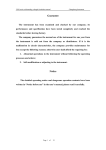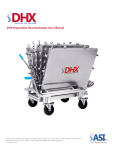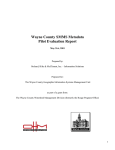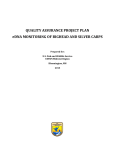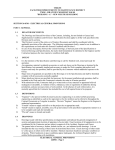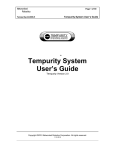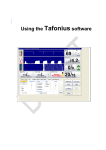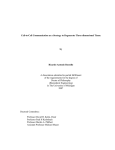Download Appendix Q
Transcript
Appendix Q Relevant Standard Operating Procedures Followed by the Upper Midwest Environmental Sciences Center and Hammond Bay Biological Station Standard Operating Procedures Upper Midwest Environmental Sciences Center Upper Midwest Environmental Sciences Center 2630 Fanta Reed Road La Crosse, Wisconsin 54603 SOP No. AEH 004.2 Date: 07/31/08 Page 1 of 2 GENERAL OPERATING PROCEDURE PROCEDURE TITLE: Weighing Chemicals APPLICABILITY: Branch of Aquatic Ecosystem Health PURPOSE: To assure quality and consistency in weighing out chemicals PROCEDURES: A. Read Material Safety Data Sheets of all chemicals that will be used during this procedure. B. Weighing Chemicals 1. Calibrate and operate balance according to specific SOP for the balance. 2. Place a clean weigh boat, piece of weigh paper or a transfer vessel on the balance pan and tare the balance. 3. Open the chemical container. Place a clean Kimwipe down on the desk top and then set the lid down on top of the Kimwipe. Use a clean spatula to dispense the chemical onto the weigh boat/paper/vessel. 4. Remove the weigh boat/paper/vessel from the balance when adding large amounts of chemical to avoid spillage and spill being weighed. When nearing the proper weight, the weigh boat/paper/vessel can be placed back on the balance. 5. Add small amounts of the chemical to obtain the desired weight on the balance. 6. If the desired weight is surpassed, remove small amounts of chemical until the desired weight is reached. Do not return the chemical to the source vessel. Discard the excess chemical in the appropriate waste receptacle. 7. After the correct weight has been obtained, carefully remove the boat/paper/vessel to avoid spilling any weighed chemical. 8. Replace the top of the chemical container and return it to the proper location. If the bottle is being used for the first time, record the “date opened” information on the chemical labeling tape. SOP No. AEH 004.2 Date: 07/31/08 Page 2 of 2 9. If the chemical being removed is a test chemical, record all necessary weights in the Test Chemical Use Log according to SOP GEN 012. 10. If a chemical container is emptied during the weighing process, remove the chemical labeling tape and wash or rinse as needed. Dispose of the container in the appropriate waste receptacle. REVIEWED BY: __________________________________ DATE: ___________ Quality Assurance Officer APPROVED BY: ___________________________________ DATE: ___________ Branch Chief, Aquatic Ecosystem Health Upper Midwest Environmental Sciences Center 2630 Fanta Reed Road La Crosse, Wisconsin 54603 SOP No. AEH 007.3 Date: 07/31/08 Page 1 of 2 GENERAL OPERATING PROCEDURE PROCEDURE TITLE: Preparing Solutions from a Liquid and/or Solid Phase APPLICABILITY: Branch of Aquatic Ecosystem Health, Upper Midwest Environmental Sciences Center, La Crosse, Wisconsin. PURPOSE: To assure that all employees are preparing solutions accurately and correctly. PROCEDURE A. Preparing Solutions from a Liquid Source 1. Measure out the required chemical volume using either a graduated cylinder or pipette, depending on the volume required. 2. Using a funnel, transfer the chemical into the flask. If transferring from a “to contain” (TC) calibrated cylinder, rinse the cylinder three times with the solvent to assure that the entire chemical is transferred. If using a pipette, add chemical directly to the flask without the aid of the funnel. Fill to 1” below volume line or approximately 90% total volume and mix (to allow for volume change with different solvents). 3. Bring the flask up to volume with the solvent (see SOP No. AEH 005 “General Procedure for Filling Volumetric Ware”). 4. Place a stopper in the flask and invert the flask 10 to 15 times in order to thoroughly mix the solution. B. Preparing Solutions from a Solid State 1. Weigh out the chemical (see SOP No. AEH 004 “Weighing Chemicals”) on a calibrated balance. 2. Using a funnel, transfer the chemical into the flask. Rinse the weigh boat/paper three times with solvent to assure that the entire chemical is transferred. 3. If the chemical does not go into solution, add more solvent and place the flask in warm water, stir with magnetic stir bar or sonicate. Once the chemical is in solution, cool to room temperature before final volume adjustment. If a magnetic stir bar is used, retrieve the stir bar and rinse with solvent into flask prior to final volume adjustment. SOP No. AEH 007.3 Page 2 of 2 4. Bring the flask up to volume with the solvent. 5. Place a stopper in the flask and invert the flask 10 to 15 times in order to thoroughly mix the solution. 6. Label flask with solution according to SOP No. AEH 011 (the solution identity, concentration, date prepared, initials of preparer, expiration date, and storage conditions). REVIEWED BY: __________________________________ DATE: ___________ Quality Assurance Officer APPROVED BY: ___________________________________ DATE: ___________ Branch Chief, Aquatic Ecosystem Health Upper Midwest Environmental Science Center 2630 Fanta Reed Road La Crosse, Wisconsin 54603 SOP No. GEN 011.2 Date: 01/07/00 Replaces: 09/05/97 Page 1 of 3 GENERALOPERATINGPROCEDURE PROCEDURE TITLE: Archiving of Regulated Test Chemicals APPLICABILITY Any test chemical, chemical formulation, degradation product. metabolite, or analytical standard that has been, is, or will be used in the registration or potential registration of a chemical with the U.S. EPA or FDA. PURPOSE: To describe basic procedures to submit and store test substances (chemicals) in the Upper Midwest Environmental Sciences Center (UMESC), La Crosse, Wisconsin, chemical archives. PROCEDURES: A. A sample of the test substance (chemical) must be submitted to the Quality Assurance Officer (QAO) and placed in the Archives before the start of any drug registration study. B. A sample that is submitted to the QAO shall have the following information to support and verify its source and authenticity: 1. Completed Form a, SOP GEN012 2. Information supporting its authenticity, purity, and physical-chemical characteristics 3. Any other information supplied by the manufacturer, and 4. Material Safety Data Sheet (MSDS). The need for a MSDS can be waived by the QAU. This written information shall be kept in a secured file cabinet under the control of the QAU. C. The size of the sample placed in the chemical archives should be at least 5 g or 5 percent of the total mass or volume of material available, whichever is less. Exceptions may be granted by the QAO for small quantity chemicals such as radioactive chemicals. D. The sample shall be submitted in a clean, acid-washed and hexane-rinsed vial. Vials can be obtained from the QAU. The vial must be labeled with the name of the chemical, its lot number, the date the sample was taken from its source, the initials of the person taking the sample and the archive location number (explained in Section F). SOP No. GEN 011.2 Page 2 of 3 E. Chemicals will be archived in one of two locations. Vials with dry chemical will be stored in a container (see Section F) in an ultra cold freezer (designated by the QAU). Storage temperature will be maintained at or below -20°C. Vials with liquid chemical will be stored in a container (see Section F) at ambient temperature in the chemical archive vault. The freezer box and the chemical archive vault are secured at all times unless chemicals are being added to or removed from the archives. F. The sample vial will be given a unique identification number (Chemical Archive Location Number) by the QAO. Chemicals will be archived in one of two containers sectioned as seen below. Each chemical in the archives will have a unique location code. designated as follows: 1. Physical location of storage a. RF= Revco Ultra cold freezer b. CV= Chemical Vault 2. Container number in Roman numerals I = container I found in the ultra cold freezer or chemical vault II = container II found in the chemical vault or ultra cold freezer o = the sample is too large and is not found in the container but is stored in the freezer or chemical archive vault with a security seal over the opening to the sample container. 2. Letter denoting row in the container (A. B. C. ... G) 3. Number denoting column in the container (1. 2. 3. ... 7) EXAMPLE: RF-I-A-1 = The sample is found in the Revco Ultra cold freezer in container I, in row A, column 1. EXAMPLE: CV- O= the sample is found in the chemical vault but is too large for the container in the vault. G. The QAU will keep records of the chemicals in the archives. These records will contain the date the test substance is placed into the archives, identity of the material, manufacturer, date SOP No. GEN 011.2 Page 3 of 3 received from the manufacturer, lot number of test substance, mass or volume of material being archived, and the name of the individual submitting the sample. H. Requests to access either the chemical archives or the information contained in the file (Section S.) must be made in writing to the QAU. REVIEWED BY: __________________________________ DATE: ___________ Quality Assurance Officer APPROVED BY: ___________________________________ DATE: ___________ Branch Chief, Aquatic Ecosystem Health Upper Midwest Environmental Sciences Center 2630 Fanta Reed Road Date: La Crosse, Wisconsin 54603 SOP No. AEH 214.4 07/31/08 Replaces: CAP 214.3 Page 1 of 4 INSTRUMENT OPERATING PROCEDURE INSTRUMENT: Balance MODEL: R200D MANUFACTURER: Sartorius SERIAL NUMBERS: 20903620, 20903676, and 39020006 USGS ID NUMBERS: 385274, 385275, and 373245 CALIBRATION FREQUENCY: Daily when in use PRECAUTIONS A. Potential Interferences 1. The balance is adversely affected by electromagnetic fields, temperature extremes, air currents, and vibrations. It must be set up where the effects of these factors are minimized. B. Safety 1. Follow Material Safety Data Sheet precautions for chemicals used. PROCEDURE A. Start-up 1. Level the balance by adjusting the leveling feet so that the air bubble is centered within the circle of the level indicator. 2. If the balance has been connected to a power source for at least 2 hours, it is ready for operation. If it is disconnected from a power source, reconnect it and allow it to warm up for at least 2 hours. 3. When the balance is in the “STANDBY” mode, press the ON/OFF button on the tare bar to activate the display and perform an automatic test of the circuitry. A “0.00000 g” weight display indicates successful completion of the test. SOP No. AEH 214.4 Page 2 of 4 4. The balance has two weight ranges: 0-42 and 0-205 g. The 0-42 g range gives weights to five decimal places. The 0-205 g range gives weights to four decimal places. Push the “42 g/205 g” button on the key pad to select the desired weight range. B. Calibration 1. External calibration (resets the internal calibration value). The balance must be externally calibrated every time it is moved to a new location, or as required by SOP No. GEN 013. a. External calibration of the balance requires an accurate calibration weight of 100 g. National Institute of Standards and Technology (NIST) Class S standard weights or American Society of Testing Materials (ASTM) Class 2 standard weights can be used for external balance calibration. b. Press the tare key on the balance for at least 3 seconds until the calibration weight appears in the display (100.0000 g). c. Place the calibration weight in the center of the pan. The weight symbol “g” should appear and a short acoustic signal indicates the end of the calibration. 2. Internal calibration (calibrates the balance using the saved external calibration setting). The balance must be internally calibrated on each day it will be used and after the balance is bumped, jarred, maintenance has been performed, or room temperature has changed by ± 5°C. a. Tare the empty balance. As soon as the display shows zero readout, press the CAL key. A “C” will appear in the display. b. The display will change to “CC” followed by a zero readout after a short wait. A beep indicates a successful calibration. 3. If the display continues to show “CC” (internal calibration) or if g does not appear (external calibration), refer to the Calibration section of the Sartorius R200D Operation Manual to correct the problem. 4. Calibration verification (verifies the precision of the internal calibration) a. Press the tare sensor “t” to zero the balance. b. Place a test weight from a set of Class 2 calibration weights in the center of the weigh pan. Note: NIST Class S standard weights can be substituted for any ASTM Class 2 standard weights mentioned in this SOP. SOP No. AEH 214.4 Page 3 of 4 c. The reading on the scale must correspond to the weight of the standard within the accepted tolerance interval stated in the Instrument Use, Calibration, and Maintenance Log (Form AEH 214.4a). d. If any standard is outside the accepted tolerance interval, repeat internal calibration (step B.2) and then repeat the calibration verification. e. If the instrument still fails the calibration verification, the balance needs to be externally calibrated (step B.1) and then repeat the calibration verification. f. If the instrument is still not in calibration, discontinue use and tag the balance with a label marked “INOPERABLE,” the date, and the operator's initials. Report the problem to the Study Director immediately and contact the proper service personnel. Describe the problem as well as any action taken in the Instrument Use, Calibration, and Maintenance Log (Form AEH 214.4a). C. Routine Operation 1. 2. Non-tared weighing a. Press tare sensor “t” to zero balance. b. Place sample on balance and read weight after stability indicator “g” is illuminated. Tared weighing a. Place weigh container on balance pan and press sensor “t” to zero balance. b. Place sample in container and read net weight directly. D. Record Keeping (recording calibrations) 1. Record results of all calibrations in the Instrument Use, Calibration, and Maintenance Log (Form AEH 214.4a). 2. Items to be recorded in the log include the date of calibration, weight set serial number, weights reported by the instrument for the Class 2 weights, initials of the operator, and any maintenance performed. SOP No. AEH 214.4 Page 4 of 4 MAINTENANCE A. Routine 1. After each use, clean weigh pan of the balance and the balance table area by wiping with a lint-free tissue dampened with methanol. B. Service Agreements (see SOP No. GEN 013) 1. A record of service on the instrument, name of service representative, the service company, and the date of service must be recorded in the Instrument Use, Calibration, and Maintenance Log (Form AEH 214.4a). C. Malfunction/Repairs (see Calibration section, step B.3) 1. Describe the problem and any action taken in the Instrument Use, Calibration, and Maintenance Log (Form AEH 214.4a). D. Record Keeping 1. Record in the Instrument Use, Calibration, and Maintenance Log (Form AEH 214.4a) the description and part number of instrument parts that are replaced. REFERENCE A. Sartorius Research R200D, R180D-*F1 Operations Manual Sartorius Instruments, 1430 Waukegan Road, PO Box 770, McGraw Park, Illinois 60085-6787. REVIEWED BY: __________________________________ DATE: ___________ Quality Assurance Officer APPROVED BY: ___________________________________ DATE: ___________ Branch Chief, Aquatic Ecosystem Health Upper Midwest Environmental Sciences Center 2630 Fanta Reed Road La Crosse, Wisconsin 546031 SOP No. CAP 407.4 Date: 05/28/10 Replaces: CAP 407.3 Page 1 of 1 TECHNICAL OPERATING PROCEDURE PROCEDURE TITLE: Validation of Analytical Procedures APPLICABILITY: Branch of Aquatic Ecosystem Health PRINCIPLE: The purpose is to provide the proper guidance for validation of analytical procedures. Before an analytical procedure can be used as part of a Good Laboratory Practice study where data may be submitted to regulatory agencies, the Study Director must make sure the proper agency guidance and recommendations are being adhered to and followed. PROCEDURE: A. For studies submitted to U.S. Food and Drug Administration (FDA), follow Guidance for Industry #64, "Validation of Analytical Procedures: Methodology". Current FDA guidance can be found at www.fda.gov/downloads/AnimalVeterinary/GuidanceCompliance Enforcement/Guidanceforindustry/ucm052379.pdf. Reference the method used in the data management system. B. For studies submitted to U.S. Environmental Protection Agency (EPA), follow EPA guidance on method validation for analytical procedures. Current EPA guidance may be found at www.epa.gov. Guidance for Methods Development and Methods Validation for the OPPTS Harmonized Test Guidelines is found at http://www.epa.gov/opptsfrs/publications/ Test_Guidlines/series860.htm. Many test guidelines are available by EPA make sure the appropriate guideline is selected for specific application. Reference the method used in the data management system. C. For all other analytical procedures, the Study Director will determine the criteria for validating the analytical procedures. REFERENCE: None REVIEWED BY: __________________________________ DATE: ___________ Quality Assurance Officer APPROVED BY: ___________________________________ DATE: ___________ Branch Chief, Aquatic Ecosystem Health Upper Midwest Environmental Sciences Center 2630 Fanta Reed Road La Crosse, Wisconsin 54603 SOP No. AEH 901.3 Date: 08/31/08 Replaces: CAP 901.2 Page 1 of 2 TECHNICAL OPERATING PROCEDURE PROCEDURE TITLE: Filtering Solvents and Solutions for Analytical Uses APPLICABILITY: Branch of Aquatic Ecosystem Health PRINCIPLE: Use of particle-free solvents is important for the operation of analytical systems to prevent flow obstructions and the introduction of air bubbles in the system. PRECAUTIONS A. Potential Interferences 1. Ensure that glassware is clean before degassing mobile phase solvents and solutions. 2. Use a compatible solvent filter type (aqueous, non-aqueous, or universal) for the solution being filtered. Refer to the product description in a products catalogue for proper filter selection. 3. Acetonitrile polymerizes. It should be filtered at least every 4 weeks if it is being used in an Ultra Performance Liquid Chromatography (UPLC) system. If a bottle of acetonitrile is open on the shelf, it is recommended to filter before use. Unopened bottles of acetonitrile may be used directly. 4. Buffer solutions prepared with salts should be filtered before use. 5. Always refer to the instrument user manual for guidance on the proper procedures for preparing solvents and solutions for use. B. Safety 1. Always wear safety glasses, a lab coat, and gloves when filtering solvents. 2. Follow the Material Safety Data Sheets for solvents used during the execution of this procedure. PROCEDURE A. Vacuum Filtration 1. Equipment SOP No. AEH 901.3 Page 2 of 2 a. Solvent filter, use a filter type compatible with the solution being filtered (aqueous, nonaqueous, or universal). Select a filter pore size based on the specific application (e.g. 0.2 micron filter for HPLC solvents). b. Glass reservoir funnel c. Fitted glass support base d. Solvent collection flask e. Clamp d. Vacuum pump (e.g. Gast® model DOA-152-AA or similar pump) with vacuum tubing. 2. Place a solvent filter between the fritted glass support base and the glass funnel. Assemble the support base and funnel with a clamp and place on top of the solvent collection flask. 3. Connect the vacuum tubing to the support base and the vacuum pump. 4. Turn ON the vacuum pump. Fill the funnel with solvent; refill as needed. 5. After the gas bubbles have vacated the solvent, turn OFF the pump, disconnect the tubing from the support base, and disassemble the support base, funnel, and solvent flask. 6. If necessary, pour the degassed and filtered solvent into a solvent reservoir minimizing agitation by slowly pouring the solvent down the inside surface of the solvent reservoir. B. Record Keeping 1. If solutions are used for UPLC or Liquid Chromatography-Mass Spectrometry (LCMS), record the type of mobile-phase solvents in the appropriate Instrument Logbook (Form AEH 237.a). 2. For all other applications, record use of solutions in instrument logbooks if applicable. REVIEWED BY: __________________________________ DATE: ___________ Quality Assurance Officer APPROVED BY: ___________________________________ DATE: ___________ Branch Chief, Aquatic Ecosystem Health Standard Operating Procedures Hammond Bay Biological Station Hammond Bay Biological Station 11188 Ray Road Millersburg, MI 49759 SOP No. LAB 303.5 Date: 15 Sep 2011 Page 1 of 3 STANDARD OPERATING PROCEDURES Laboratory PROCEDURE TITLE: Niclosamide determination using the HPLC (high performance liquid chromatography) method SCOPE: Describes general HPLC parameters for determining concentrations of Niclosamide in water. PROCEDURE: A. Reagents used: 1. 2. methanol, HPLC grade 3. 4. Niclosamide (analytical grade, ~99% pure) N,N Dimethylformamide (DMF), HPLC grade water, HPLC grade 5. filtered lake water 6. sodium acetate buffer (3 ml glacial HAc and 0.56 g NaAc3H20 diluted to 1 L, pH 3.8) B. Equipment: 1. HPLC system which includes sample auto-injector, detector, gradient pump, and chromatography work station for data analysis 2. Waters μBondapak C-18 reverse phase column (150 x 3.9 mm and 10 μm irregular packing material 3. Filter system - vacuum operated Millipore filter apparatus and type A/E Gilman 47 mm glass fiber filters C. Prepare Niclosamide Standards 1. Prepare 100 mg/L Niclosamide stock solution using HBBS SOP No. LAB 423.0 2. Using the 100 mg/L stock solution, prepare at least three working standards using filtered lake water as the diluent. The concentrations of the working TFM standards should bracket the samples to be analyzed. 3. Calculation for the working Niclosamide standards: mg/L Niclosamid e = (mL stock soln.) (mg/L stock soln.) 100mL D. Method: 1. 2. Mobile phase: 75% methanol, 23% deionized water, 2% NaAc/HAc buffer. Make sure there is enough mobile phase for the days work. Degas mobile phase after preparation and use online degassing system during analysis. Operating conditions: a. 8 minutes of mobile phase at 2.0 mL/min, isocratic flow b. Injection volume 50 μL c. Detector wavelength: 330 nm d. Retention time: about 2.5 min 3. Run standards, blank, and samples: Refer to operator’s manual to operate HPLC 4. Record data in appropriate HPLC operator’s log book a. Record quality assurance data, calibration data, and analytical operating conditions in the operator’s log book b. Record date, procedure, mobile phase, column identification, injection volume, detector wavelength, concentration of standards, peak area, and retention time. E. Calculations: 1. The HPLC software will determine retention times, peak area, correlation, slope, intercept and concentration. Approved by: _____________________________________ Date: _______ Laboratory Supervisor Reviewed by: ______________________________________ Date: _______ Quality Assurance Representative Hammond Bay Biological Station 11188 Ray Road Millersburg, MI 49759 SOP No. LAB 322.4 Date: 13 Sep 2011 Page 1 of 3 STANDARD OPERATING PROCEDURES LABORATORY PROCEDURE TITLE: TFM determination using the HPLC (high performance liquid chromatography) method SCOPE: Describes general HPLC parameters to determine concentrations of TFM in water PROCEDURE: A. B. C. Reagents used: 1. methanol, HPLC grade 2. water, HPLC grade 3. sodium acetate buffer (3 ml glacial acetic acid and 0.56 g NaAc3H2O (reagent grade) diluted to 1 L with HPLC grade water, pH 3.8) 4. filtered lake water - a vacuum operated system with glass fiber filter is used for the removal of particulates 5. TFM (analytical grade, ~ 99% pure) Equipment: 1. HPLC system which includes sample auto-injector, detector, gradient pump, and chromatography work station for data analysis 2. Waters Spherisorb C-18 reverse phase column (250 x 4.6 mm and 10 micron particles) 3. Filter system - vacuum operated filter apparatus and glass fiber filters for filtering lake water Prepare TFM Standards: 1. Prepare 1000 mg/L TFM stock solution using SOP No. LAB 423.0. 2. Using the 1000 mg/L TFM stock solution, prepare at least three working TFM standards using either filtered lake water or buffered HPLC grade water as the dilutant. The concentrations of the working TFM standards should bracket the TFM samples to be analyzed. 3. Calculation of working TFM standards: mg/L TFM = (mL stock soln.) (mg/L stock soln.) 100 mL D. Method: 1. Mobile phase: 67% methanol, 30% deionized water, 3% NaAc/HAc Buffer. Make sure there is enough mobile phase for the days work. Degas the mobile phase after preparation and use online degassing system during analysis 2. Operating conditions: a. 15 minutes of mobile phase at 1.5 mL/min isocratic flow b. Injection volume:50 μL. c. Detector wavelength:300 nm. d. Retention time: about 4.5 min. 3. Analyze standards, blank, and samples: Refer to owner’s manual for operation of HPLC 4. Record data in appropriate HPLC operator’s log book a. Record quality assurance data, calibration data, and analytical operating conditions in the operator’s log book b. Record date, procedure, mobile phase, column identification, injection volume, detector wavelength, concentration of standards, peak area, and retention time. E. Calculations: 1. The HPLC software will determine retention times, peak area, correlation, slope, intercept and concentration. Approved by: _____________________________________ Date: _______ Laboratory Supervisor Reviewed by: ______________________________________ Date: _______ Quality Assurance Representative Hammond Bay Biological Station 11188 Ray Road Millersburg, MI 49759 SOP No. LAB 333.5 Date: 2 Dec 2003 Revised: 27 April 2010 Page 1 of 13 Standard Operating Procedures Laboratory PROCEDURE TITLE: Receipt, Identification, Storage, and Handling of TFM and Niclosamide Analytical Standards. DEFINITION OF TERMS LAMPRICIDE ANALYTICAL STANDARD: The Analytical Standard is a commercially prepared high purity formulation (usually ≥99% pure) of 3-trifluoromethyl-4-nitrophenol (TFM) or niclosamide. The analytical standard must be accompanied by a certificate of analysis (COA) stating the purity, and a material safety data sheet (MSDS). PROCEDURES: A. Receipt and Identification 1. Upon receipt of material, inspect the package and contents to determine that the vessel containing the analytical standard is undamaged, and that the COA and MSDS are included. a. b. c. d. If damage to the vessel has occurred, the analytical standard will be returned and replaced. If COA and/or MSDS are not included in package, contact supplier and request. File the MSDS in the appropriate MSDS folder located in the main lab. Place the COA in the chemical usage log. 2. After receiving the analytical standard in satisfactory condition, prepare a Chemical Usage Log (attachment 1) and record the following information: a. Date of receipt b. Manufacturer c. Name of the analytical standard d. Quantity e. Purity f. Lot number g. The physical characteristics of the analytical standard h. The Chemical Abstracts Service number (CAS) 3. The Chemical Register and User Log book will contain sufficient pages to record all amounts of all chemicals used on all research as well as the following items in the order listed: a. A copy of this standard operating procedure b. Lined, blank pages for recording usage entries (see attached Form 1) 4. The original weight of the chemical and container, with cap, will be determined by weighing it on an appropriate balance. Record this weight on the Chemical Usage Log. B. Storage of Analytical standard 1. The analytical standard will be stored in a secured area under non-hazardous conditions and with low potential for degradation. Normally, this will be in a freezer or vault that is cool, dry, ventilated, and darkened. C. Handling of the Analytical standard 1. If the analytical standard is stored in a freezer, allow it to come to ambient temperature before weighing and withdrawing subsamples. 2. Before each use, the initial weight of the analytical standard and its container shall be determined by weighing it on an appropriate balance. Record in the Chemical Usage Log. Note: Containers should be weighed with the cover on the container. If this is not done, indicate on the log that the container without the cover was weighed. 3. The amount of chemical taken from the container will be weighed into the appropriate tared vessel and the weight will be recorded on the Chemical Usage Log. 4. After the chemical has been withdrawn from the storage container, reweigh the container and its contents and record all information on the Chemical Usage Log. 5. Repeat Steps 2, 3, and 4 each time the chemical is removed. 6. Return the remaining chemical to the storage area. 7. When the Chemical Usage Log is full or when all chemical has been used, the log shall be archived in the Laboratory facility archives. D. Verification of the Purity of the Analytical Standard. 1. The purity reported by the manufacturer of the standard will be verified before the standard is used. This is generally done by HPLC method. See HBBS SOP 303.5 for the specifics regarding the determination of niclosamide concentration and HBBS SOP 322.4 for the determination of TFM concentration. 2. Determine % purity by preparing a sample of any concentration and comparing total peak area of TFM or Niclosamide to peaks of unknown origin, totaling 100% when added together. The HPLC software will determine % of the total peak area for the user. attachment 1 CHEMICAL USAGE LOG Chemical name, label information, purity, description, lot number ______________________________________________________________________________ ______________________________________________________________________________ _______________________________________ Manufacturer __________________ Expiration date ________________ Recvd. by _____________________ Recvd. from ____________________ Date recvd. ___________________ Amount recvd. __________________ CAS no. ______________________ Amount archived ________________ Initial weight (with cap on) of chemical and container (g) Initials Date Weight of chemical and container (g) after removal Amount removed (g) Study # or Purpose Hammond Bay Biological Station 11188 Ray Road Millersburg, MI 49759 SOP No. LAB 334.1 Date: 13 April 2011 Page 1 of 2 STANDARD OPERATING PROCEDURES LABORATORY PROCEDURE TITLE: Archiving of Chemicals AREA OF APPLICABILITY: This procedure is applicable to all research staff at the Hammond Bay Biological Station (HBBS). SCOPE: To describe the archiving procedures for chemicals at HBBS. PROCEDURE: A. The chemical to be archived must be submitted to the station chemist and shall have the following information to support and verify its source and authenticity: chemical name, synonym (if any), Chemical Abstracts Service Number (CAS number), name of manufacturer, manufacturer's lot number, date of receipt, who the sample was received from, information supporting its authenticity, purity, physical-chemical characteristics, and a Material Safety Data Sheet (MSDS). B. The archived sample should be at least 5 g or 5 percent of the total mass or volume of material available, whichever is less. C. The sample shall be submitted in a new brown 4- or 8-mL vial with a screw-on teflon cap. The vial should be labeled with the name of the chemical, its lot number, and date the sample was taken from its source. D. The station chemist or chemist's representative will place a sample of the chemical into the archive vial. A piece of security tape will be placed over the cap of the vial in such a manner that the contents cannot be removed without breaking the security tape. The tape will be signed and dated. E. Archived chemicals will be stored in the archive refrigerator located in the main laboratory. Approved by: _____________________________________ Date: _______ Laboratory Supervisor Reviewed by: _____________________________________ Date: _______ Quality Assurance Representative Hammond Bay Biological Station 11188 Ray Road Millersburg, MI 49759 SOP No. LAB 335.3 Date: 14 Sep 2011 Page 1 of 6 STANDARD OPERATING PROCEDURES LABORATORY PROCEDURE TITLE: Preparation and packaging of TFM Field Standards for Sea Lamprey Control Agents. AREA OF APPLICABILITY: This procedure is applicable to the chemist and chemistry lab technician at the Hammond Bay Biological Station. SCOPE: To describe procedures for preparing and packaging TFM field standards for sea lamprey control agents. PROCEDURE: A. Reagents used: 1. Saturated Na borate solution a) Add 8.0g Na2B4075 H20 to 100 ml DI water and mix. b) Crystallized sodium borate should remain in the bottom of the flask to indicate saturation. c) Stability - indefinitely 2. Treatment-grade TFM(~33 % active ingredient as 3-trifluoromethyl-4nitrophenol) 3. 99% pure analytical TFM for making analysis standards 4. HPLC grade methanol 5. DI water for field standard diluent B. C. 6. HPLC grade deionized water for preparing standards, and for HPLC analysis 7. NaAc/HAc buffer (5 ml glacial HAc and 1.552 g NaAc diluted to 1 L with deionized water) 8. TFM stock solution(≈1000 mg/L) for preparing working standards 9. TFM standards that will bracket field standard concentrations, using HPLC grade water as the diluent, and buffered with sodium borate solution (0.4 mL saturated buffer per 100mL) Equipment: 1. HPLC with analytical software 2. Waters Spherisorb reverse phase column (250 x 4.6 mm and 10 micron particles) 3. stand mixer 4. heat sensitive shrink wrap sized for 250 mL bottles, or tamper evident tape. 5. heat gun for applying shrink wrap 6. leak proof, polyethylene bottles, 250 mL Preparation procedure 1. Fill a large vessel (preferably a polypropylene 5 gal carboy with a bottom dispensing spigot) with enough deionized water to prepare the desired volume of TFM. 2. Add saturated sodium borate buffer in the ratio of 4 mL/L of water. 3. Using the following formula, add the appropriate amount of technical grade (t.g.) TFM to achieve the desired concentration. Add only borate buffer to the 0 mg/L field standard. X Liters t.g. TFM = (desired conc. TFM mg/L)(final volume TFM L) conc. stock soln. mg/L X=unknown 4. D. Using the mixer, mix the solution for 5 or more minutes. Ensure complete mixing of any concentrate splashed onto inner sides of container by capping and mixing by hand as well. Dispense solution through spigot several times during mixing to avoid leaving unmixed solution in the dispensing line. Analytical Standard Preparation 1. Prepare TFM stock solution (≈1000 mg/L) SOP LAB 423.0 2. Prepare 3 or 4 TFM standards which bracket the expected concentration in the samples (4-12 mg/L) a) standards must be buffered with borate buffer (0.4 mL/100mL) E. F. Verification of concentration procedure 1. Sample each TFM carboy through the dispensing line. 2. Using HBBS SOP No. LAB 322.4 entitled “TFM Determination Using the HPLC Method” analyze the samples for TFM concentration. Adjusting concentration of TFM field standards 1. Depending on results, add deionized water or TFM to achieve desired concentration. a) If the TFM concentration is greater than the desired concentration, add DI water to the TFM field standard. i. Determine L of DI water to add: X final volume (determined TFM mg/L )(Vol of TFM std) Desired TFM mg/L X final volume Vol prepared std Vol of DI water to be added b) if the TFM concentration is less than the desired concentration, add TFM to the TFM field standard. i. Determine mL of TFM to add: Liters conc. stock sol. to be added G. (desired conc. mg/L - determined conc. mg/L )(Vol. of TFM std.) Conc.stock 2. If a change is made in the concentration, the standard must be thoroughly mixed again, following procedures in section C4. 3. If change is made, another sample must be analyzed for concentration. 4. Once desired concentration is reached, dispense 10-30mL of each standard into an appropriate shipping container. One sample from each concentration will be sent to Upper Midwest Environmental Science Center (UMESC) LaCrosse, WI, for confirmation of the concentration. 5. Label as follows: 01UMESC01.04 where the first two digits designate the year, followed by intials UMESC, followed by sample number and a period. The digits following the period describe the concentration of the sample in the bottle, which will be 00, 04, 08, or 12. Packaging procedure 1. Dispense approximately 200 mL of TFM field standard into 250 mL polyethylene leak-proof bottle. 2. Cap in a timely manner to avoid evaporation or contamination. 3. Apply labels formatted as follows: 11LBS031.04 where the first two digits designate the year, followed by initials of receiving control unit, followed by a unique designated number and a period. The two digits following the period describe the concentration of the sample in the bottle, which will be 00, 04, 08, or 12. 4. Apply shrink wrap using heat gun, or apply tamper evident tape. 5. Include documentation of transfer, and documentation of identity and quantity of each batch of field standards sent to a control unit. Approved by: _____________________________________ Date: _______ Laboratory Supervisor Reviewed by: _____________________________________ Date: _______ Quality Assurance Representative Hammond Bay Biological Station 11188 Ray Road Millersburg, MI 49759 SOP No. LAB 423.0 Date: 28 July 2010 Page 1 of 3 STANDARD OPERATING PROCEDURES LABORATORY PROCEDURE TITLE: Preparing TFM and Niclosamide Solutions SCOPE: To describe procedures for preparing various TFM and Niclosamide stock solutions and standards. A. 99% pure TFM stock solution 1000 mg/L 1. Record initial and final weight of the container, and weight of sample removed, on the appropriate form in the Chemical Register and User Log. 2. Tare a 100 mL volumetric flask. 3. Accurately weigh out 0.100 g of 99% TFM. 4. Record weight (X) to the nearest 0.1 mg. 5. Add approximately 3 mL Dimethylformamide (DMF) to dissolve TFM and dilute up to 100 mL using deionized or HPLC grade water. 6. Calculate concentration of TFM stock solution: mg/L stock TFM = B. (X mg TFM)(.99) 1000 mL 100 mL 1L TFM working standards 1. Prepare working standards by diluting 99% pure TFM stock solution with test water to desired concentrations which bracket the expected concentration in the samples. 2. Use equation to determine X mL of stock solution required to prepare each concentration: XmL stock TFM = desired Conc. TFM (mg / L)*desired Vol. Std .(mL) conc. stock TFM (mg / L) C. Standards for TFM quality assurance testing 1. Prepare three TFM standards of about 700 mg/L, 1100 mg/L, and 1500 mg/L. a. Tare 100 mL volumetric flask on the analytical balance. b. Log 99% pure TFM weight data (initial container weight, sample weight, and final container weight) on the appropriate form in the Chemical Register and User Log. c. In a tared 100 mL volumetric flask, weigh out about 0.07g, 0.11g, or 0.15g of 99% pure TFM, dissolve in approximately 3mL dimethylformamide (DMF) and dilute to 100.0 mL with HPLC grade water. d. Record weights to the nearest 0.1 mg and calculate standard concentrations from the recorded weights. mg/L TFM = D. Niclosamide stock solution (100 mg/L) 1. 2. 3. 4. 5. Log container initial, sample, and container final weight data into the chemical log book, on the appropriate form. In a 100 mL volumetric flask accurately weigh out 0.010 g of >99% niclosamide. Record weight (X) to the nearest 0.1 mg. Dissolve the niclosamide with DMF and dilute up to 100 mL using DMF. Calculate concentration of niclosamide stock solution: mg/L stock niclosamid e = E. (g TFM)(1000 mg)(1000 mL) (100 mL)(g)(L) (X mg niclosamid e) (.994) 1000 mL 100 mL DMF 1L Niclosamide field standard (100 mg/L) for Sea Lamprey Control Agents 1. 2. 3. In the 99% Niclosamide Log, be sure to log in the weight data (container initial, sample, and container final weight). In a 50 mL beaker accurately weigh out 0.100 g of 99% niclosamide. Record weight (X) to the nearest 0.1 mg. 4. 5. Dissolve the niclosamide in DMF, transfer to a 1000 mL volumetric flask, rinsing well with a wash bottle filled with DMF, and dilute up to 1000 mL using DMF. Mix by inverting. Use the ultrasonic bath if necessary, to aid Niclosamide going into solution. Approved by: _____________________________________ Date: _______ Laboratory Supervisor Reviewed by: ______________________________________ Date: _______ Quality Assurance Representative





































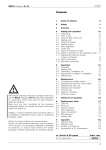

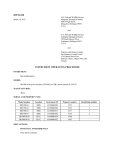

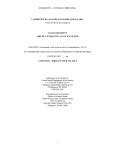
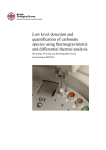
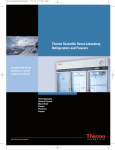
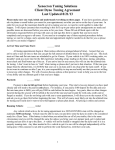

![BAYGON TECHNICAL [LABEL] - Great Lakes Fishery Commission](http://vs1.manualzilla.com/store/data/006512050_1-85aac928ab0b400aff193a02b74b8eba-150x150.png)
